Potatoes
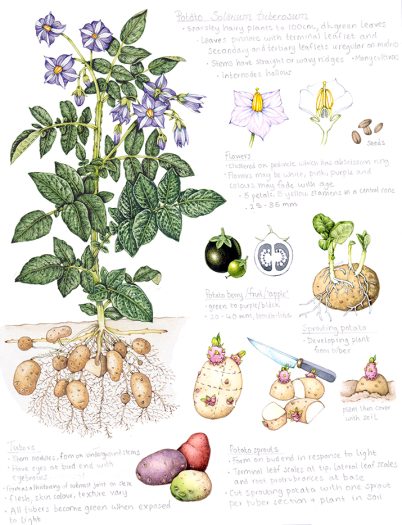
Potatoes are ubiquitous vegetables, a staple in the west since their introduction from South America in 1590. They’re bought in shops, planted in gardens, made into crisps and fries; but as well as being a vital food crop, they’re also rather beautiful plants.
Varieties of Potato
There are hundreds of different potato cultivars. Some bear potatoes early in the year, others not until autumn. Some are short and bushy plants, others stand tall with far fewer leaves. The potatoes themselves vary in colour of flesh and skin, in size, in texture. Flowers of the potato plant are equally variable in colour, with the added complication of fading with age. As a mere amateur, I’m not going to try and untangle or name-check different potato cultivars. This blog is a basic overview of the humble potato plant.
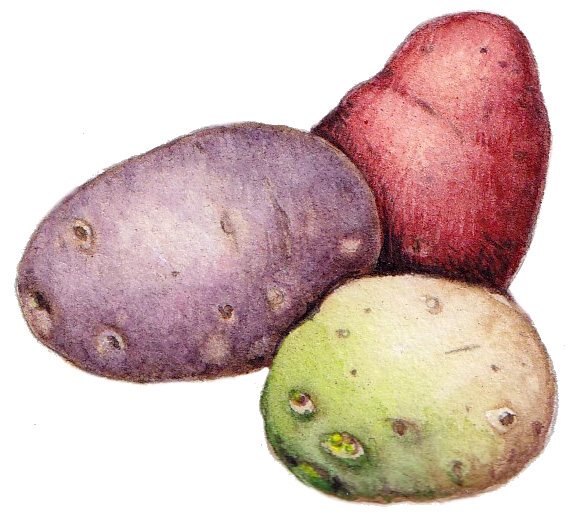
Potato variety
Solanaceae: The potato’s family
The Solanaceae family consists of 102 genera and a slew of economically important plants. Now grown across the world, Solanaceae food crops include the Capsicum or pepper family; tomatoes Solanum lycopersicum; aubergines Solanum melongena, and potatoes Solanum tuberosum. Economically enormous, tobacco Nicotiana tabacum is a member of the Solanaceae.
Many of our ornamental garden plants belong to this family too; Petunia, Datura, Brugmansia and Lycium spring to mind.
So too do some highly toxic plants including Deadly nightshade Atropa belladonna, Henbane Hyoscyamus niger, and Bittersweet Solanum dulcamara. Some of these are used to make sedatives, stimulants, and antispasmodics.
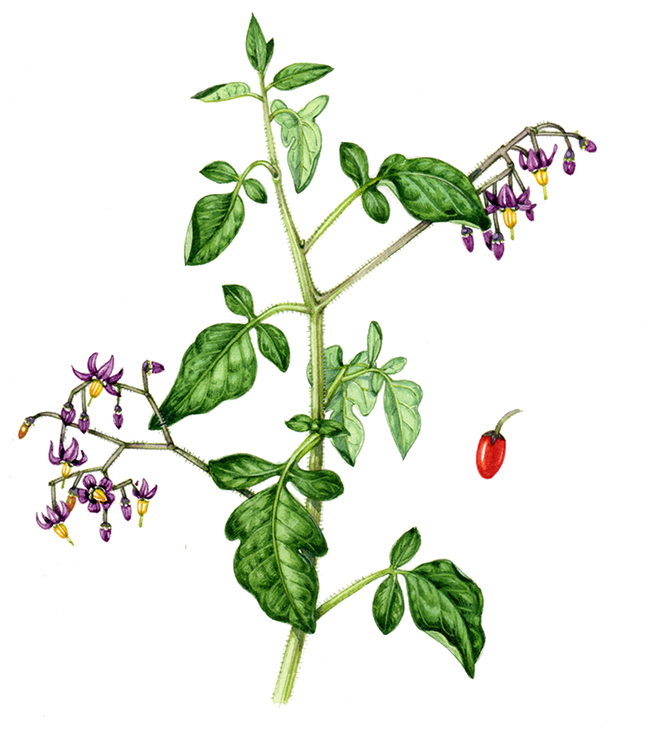
Bittersweet Solanum dulcamara
Solanaceae, Potatoes, and poison
This toxicity isn’t limited to the Nightshades. It’s easily forgotten that the potato becomes toxic when it becomes green or sprouts. The toxicity comes from the alkaloid alpha-solanine which the tuber produces. According to Wikipedia, solanine poisoning causes, “nausea, diarrhea, vomiting, stomach cramps, burning of the throat, cardiac dysrhythmia, nightmares, headache, dizziness, itching, eczema, thyroid problems, and inflammation and pain in the joints.”
Toxic effects from plants like Deadly nightshade include dilated pupils, laboured breathing, and renal failure; in livestock as well as humans. Still, this notoriously never stopped ladies of the Italian court from putting drops of Belladonna in their eyes to dilate the pupils, thus making them seem more lustful and attractive. And even today, optician’s eyedrops contain deadly nightshade. (For more on this, look at Healthline’s article).
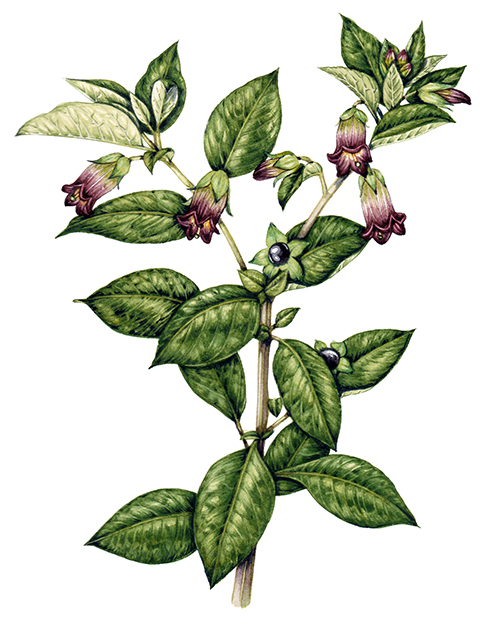
Deadly nightshade Atropa belladonna
However, there’s no reason to be poisoned by nightshades or potatoes, just be aware that the family has a dark side.
Potato Plant: Growing a potato plant
Potato plants grown up to 1m tall, and although they can grow from seed it’s commoner to have them sprouting from sprouting (or “chitting”) potatoes.
This is easy to achieve. Either forget about your potatoes in the back of a cupboard, or intentionally leave some in the light. They are likely to sprout. Generally, there’s one main sprout at the far or bud end of the tuber. Other sprouts may be present, as may lateral leaf scales. You may prefer to buy seed potatoes. Place each potato, “eyes” up, in an egg box and keep them somewhere cool and light. If you’re using a sprouting potato, cut your potato and let each bit with a sprout on grow. Once the sprouts are about 2cm long, they can be planted out in the ground. The RHS has more on this, as does Grower Expert.
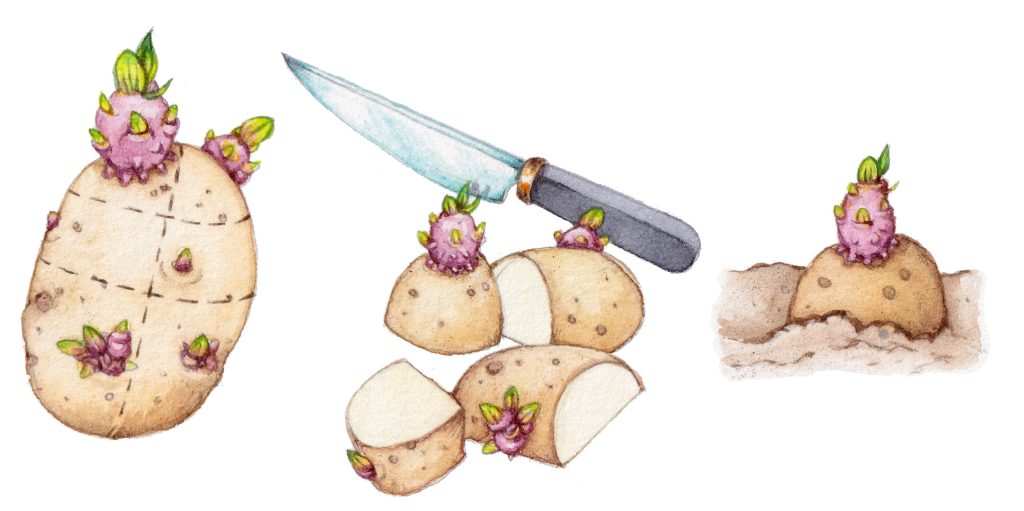
Chitted potatoes
Sprouts may be greenish, pink, white or purplish. They produce little rootlets at their base, which is how the plants start growing.
Potato Leaves
Leaves of the potato are paired leaflets, borne either side of a stem. This arrangement is known as “irregularly pinnate”. There’s one terminal leaflet present. There are also secondary and sometimes tertiary leaflets running along the midrib edge. These grow irregularly. Leaves tend to be slightly hairy and a dark green, although there is variation between cultivars.
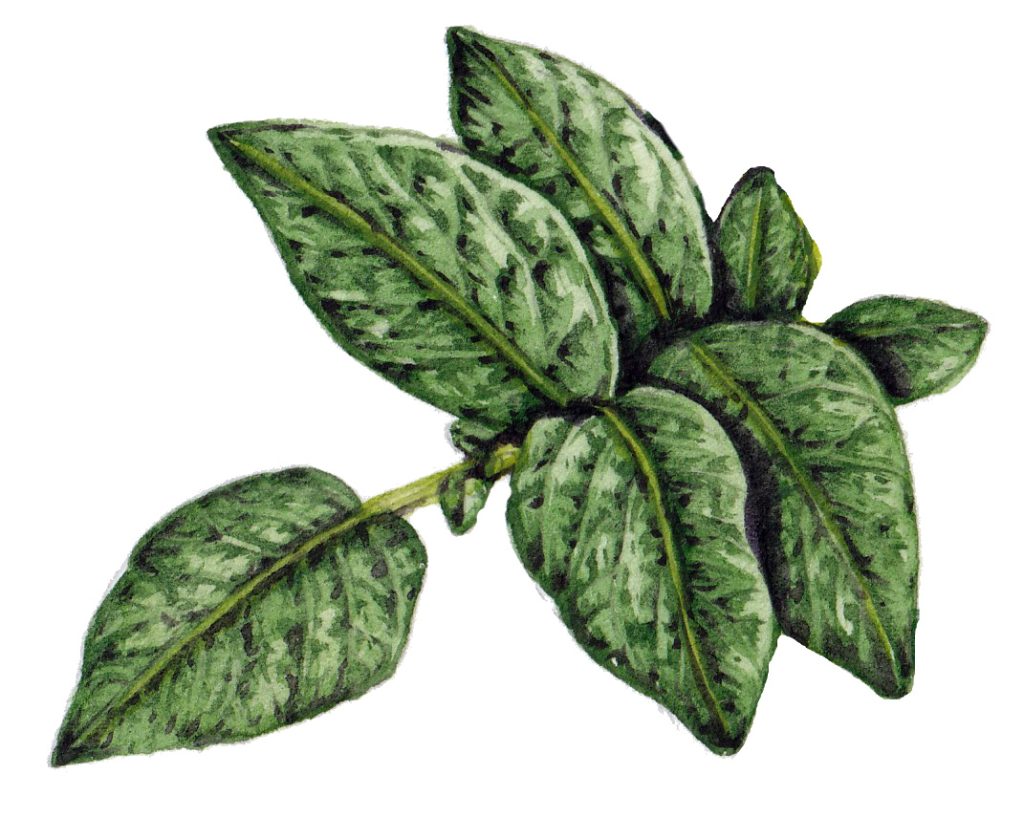
Potato leaf
The potato leaf is attached to the stem with a petiole.
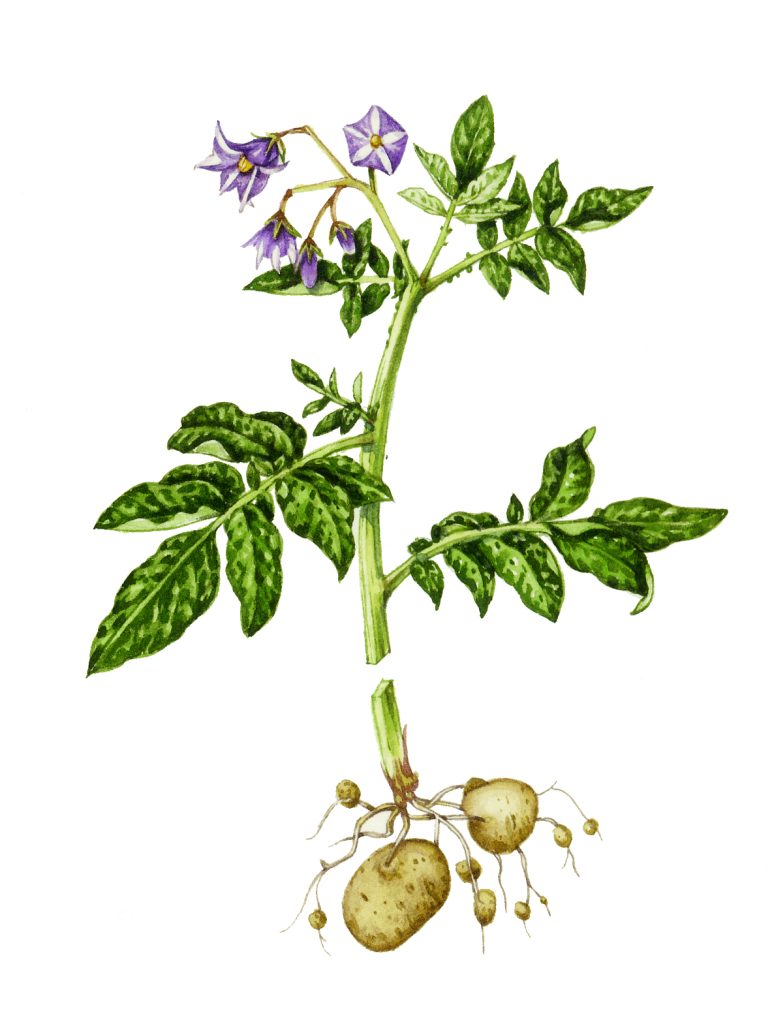
Potato stems
Hollow between branches, the stem is ridged. Often wings will grow along its edges. These can be straight or wavy, depending on what potato you’re growing
Generally, potato plant stems are a fresh pale green; in some cultivars this may be flushed red, especially toward the flowers.

Potato stem
Potato flowers
There’s a lot of colour variety between different potato flowers. Some are white, some purple, some mauve or pink. Colours can change if the flowers fade over time. All have 5 petals, and 5 golden anthers formed into a central cone.
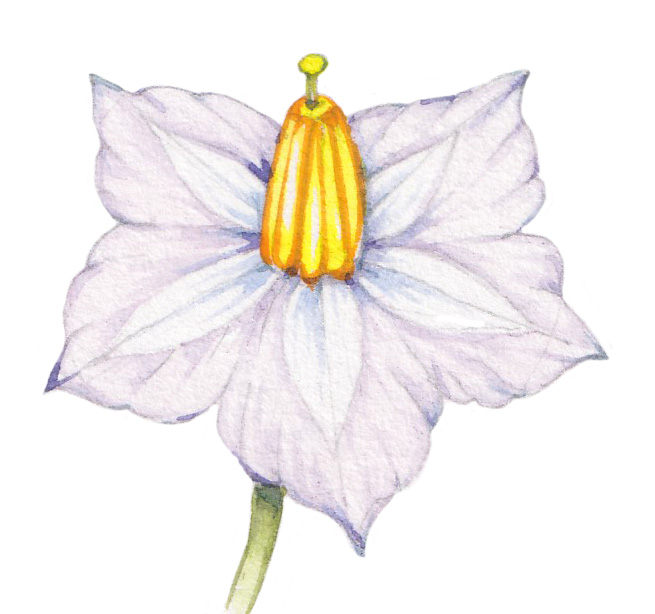
White Potato flower
Depending on type, the flowers appear May through August. Being self-pollinators, there’s no need for the plant to attract bees, butterflies or other pollinators. The pollen is released from the anther and either travels down the stigma of that same flower, or of a neighbouring bloom.
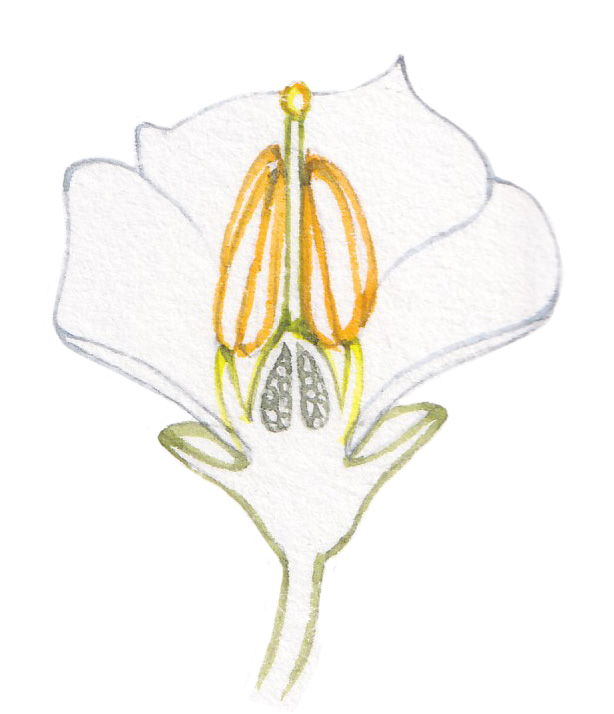
Cross section of flower
The flowering stem, or peduncle, has an abscission ring. This lets the flower break off easily at maturity. Peduncles may be coloured in reds and purples, or speckled with crimson; and if not then the scar left from the abscission is often coloured. This can help in identifying what potato cultivar you’re growing.
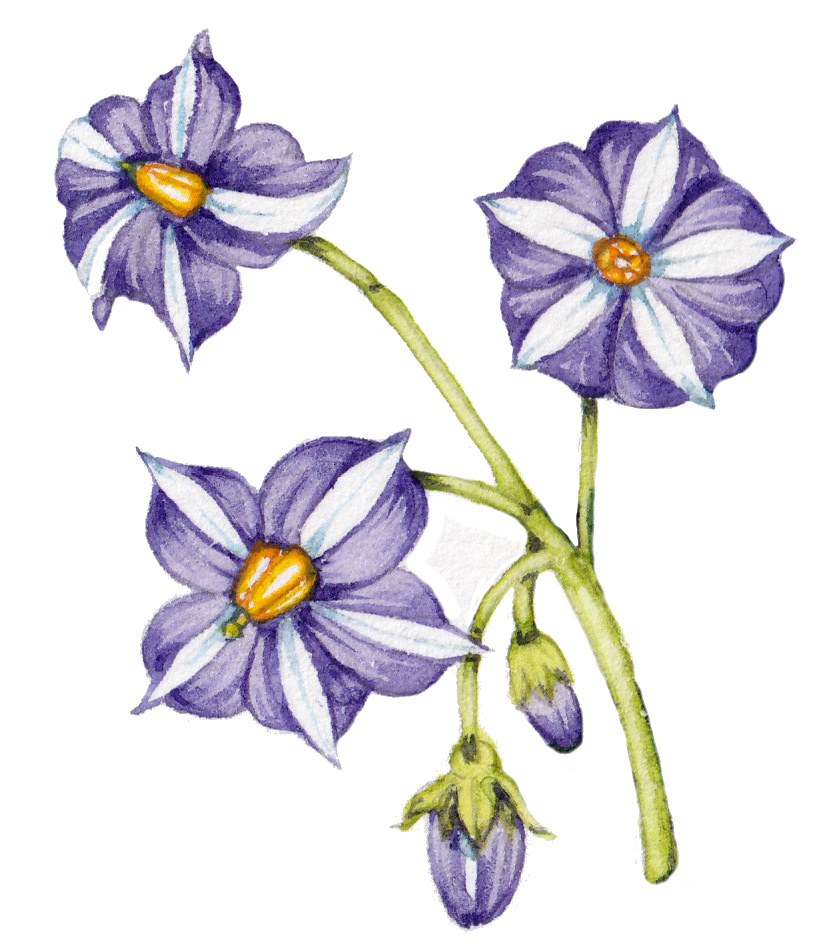
Purple potato flowers
Potato fruit
Yes, potatoes produce fruit. These look a lot like green tomatoes, both as berries and in cross section. However, they are green, becoming black when ripe. And are poisonous.
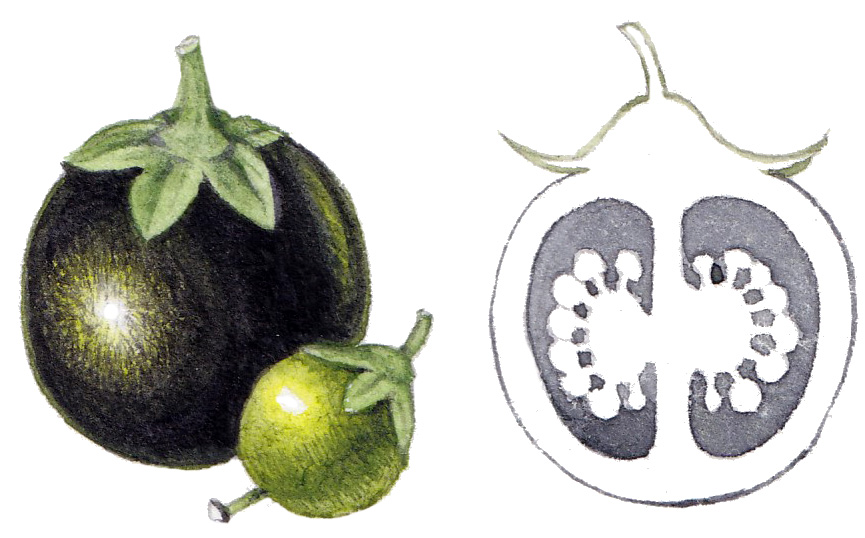
Potato fruit
Potato tuber and roots
The tuber is the part of the potato that we eat. It grows underground, on the end of of subterranean stems which bear these tubers. The last joint of the underground stem will swell and thicken, and turn into our potato. They continue to swell with age, so older potatoes tend to be larger than little “new” potatoes. There are roots present too. Normal branched, fibrous roots provide water and nutrients and grow as deep as 140cm (Acta Agriculturae Scandinavicae Vol 65). Rhizomes (or stolons) grow just below the surface, putting out scale-like leaves and growing adventitiously. For more on root variety, check out my blog.
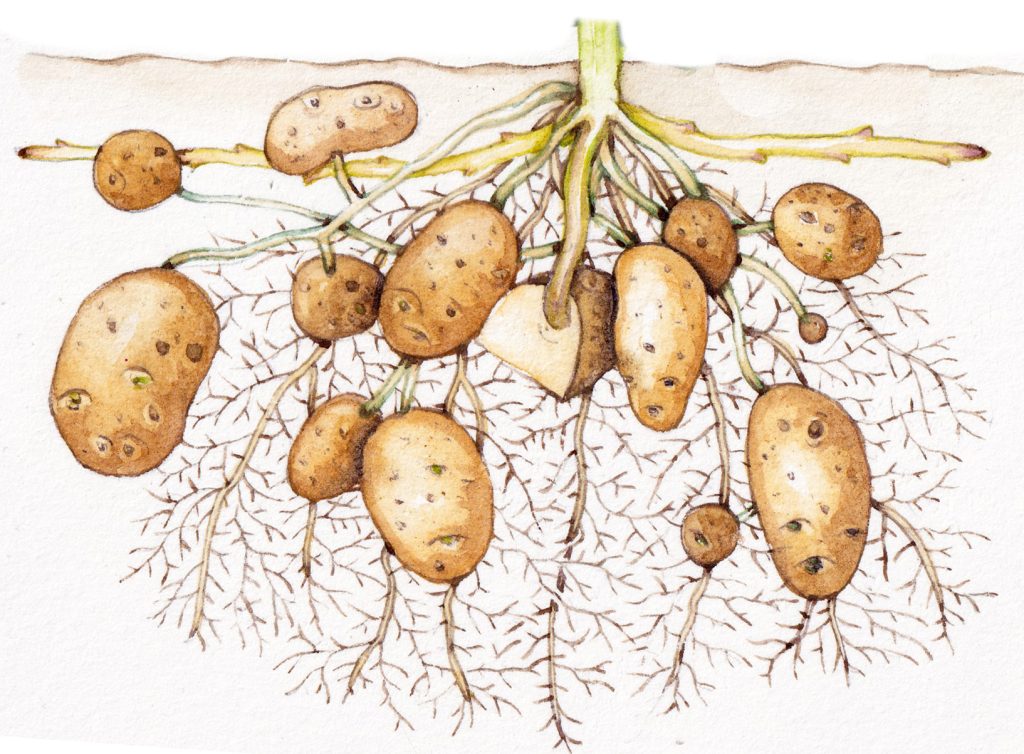
Potato roots
The tubers have a stem end, where they join to the underground stem, and a bud end, which is distal to the stem junction. It’s at this far end that you find the potato eyes. these are actually little dents from which new potato plants can sprout and grow. The birth places of the sprouts we mentioned before. Often they have ridges above them, which are known as “eyebrows”.
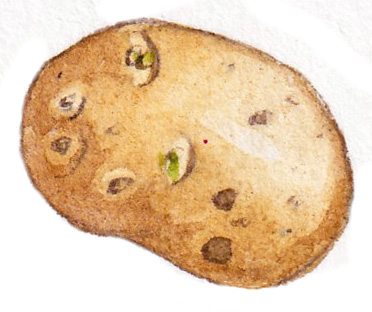
Potato with green sprout (eye) and eyebrow above
The skin colour can be white, like a Maris piper, or a deep pink, like a Rooster potato. Some heritage cultivars are a deep purple. Flesh colour varies too, depending on what type you’re growing, as does colour of sprout and the texture of the tuber. However, when exposed to light, all potato tubers will go green!
Harvesting potatoes
If you’re growing potatoes at home, a good rule of thumb is to harvest your potatoes when the lower leaves begin to yellow and become limp. This takes between 70 and 120 days. There are few gardening jobs more enjoyable than digging up potatoes, and shaking the tubers free of the roots.
Eating Potatoes!
So once you’ve learned about your potato plant, and perhaps taken a harvest, you’ll want to know what to do with the tubers.
The options are as varied as the potato types available. You can mash them. Boil them. Roast them. Bake them and serve with grated cheese or baked beans. Cut them into french fries (chips) and serve with them with vinegar, mayo, or ketchup. Hack them into wedges and roast them. Thinly slice them and layer them to make an elegant dauphinoise. Ambitious folk may want to cut them excceding thin and fry them into crisps (chips in you’re in the US).
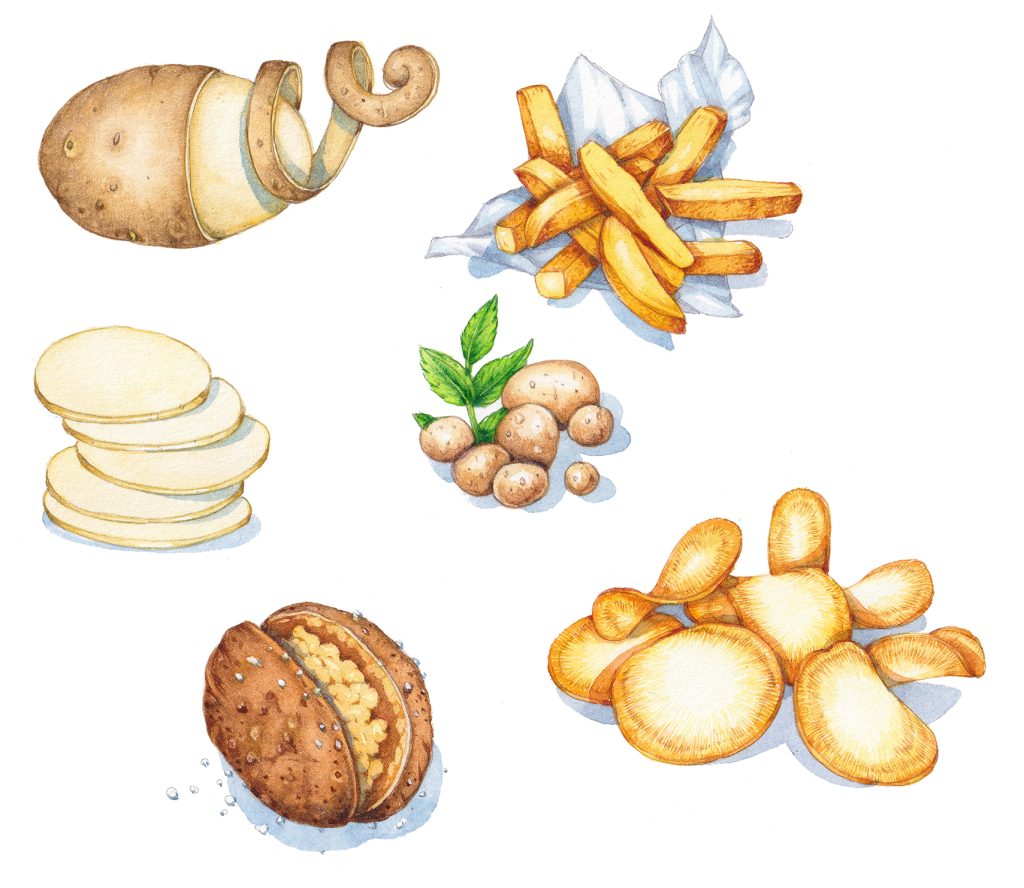
Potatoes care eaten in any number of forms!
Alternatively, leave some exposed to the light, to sprout. And start the whole cycle again.
More on Potatoes
There are endless rabbit holes down which you can plunge when it comes to researching potatoes. From the horrors of the Irish Potato famine which is thought to have killed over a hundred thousand (and which was caused by the potato blight Phytopthera infestens and appalling British governance), to the perils caused by the Colorado Potato beetle Leptinotarsa decemlineata (a notifiable pest here in the UK), and the first recorded cultivation of the potato in Peru over 8,000 years ago.
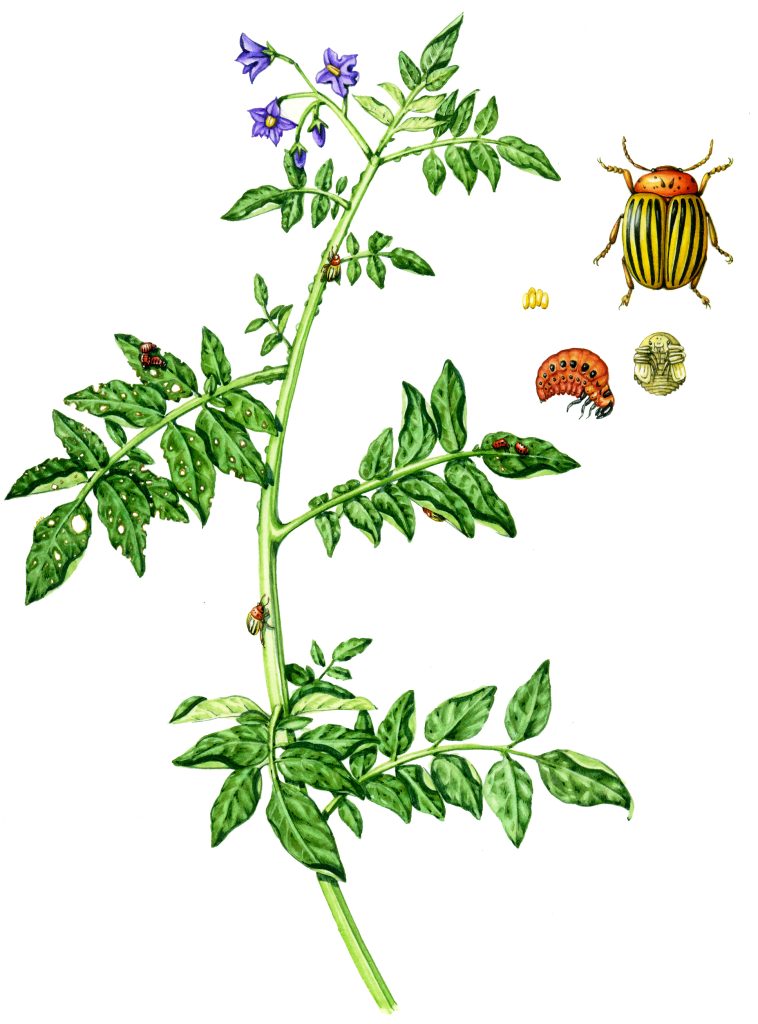
We’ve lived with the humble potato a mighty long time, and I relish having this opportunity to look a little closer at such an important plant.


as always a joy to read. thank you for sharing
Aww thanks Beth!
Hi Lizzie, hope this finds you well. Apologies for not commenting recently but have been rather busy on the advisory front.
Keep well
Regards
Peter
I came to this site looking for information on gorse.(then drifted to potato) The information contained is excellent and the illustrations are beautiful.